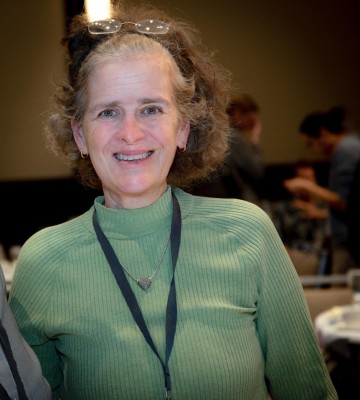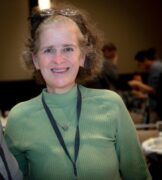
Susan Hough, seismologist at the United States Geological Survey in Pasadena, and “Earthquake Response Coordinator” of the office on the Caltech campus is now taking charge with her seismologist sisters as the 2019 Doo Dah Parade Grand Marshals. The parade takes place on Sunday, November 24, in East Pasadena, stepping off at 11:00am.
Elizabeth Cochran (USGS seismologist), Christine Goulet (USC, engineering seismologist), Voon Hui Lai (Caltech graduate student), Caleste Labedz (Caltech graduate student), Susan Owen (JPL, geophysicist), and Kate Scharer (USGS geologist) join Hough to bring the shake, rattle and roll to Doo Dah. Each of these women have significantly contributed to the advances in the understanding of earthquakes and earthquake preparedness.
Hough remembers attending the Doo Dah parade some years ago. She remembers in particular an entry that catapulted cooked hot dogs from bazookas. This was the BBQ & Hibachi Marching Grill Team, a perennial Doo Dah Parade favorite (and 2005 Grand Marshals) until they retired.
How does Hough regard being Doo Dah Grand Marshal when she opines on the richness and importance of her research and work as a seismologist? “I thought I’d experienced the epitome of my career… until I was asked to be a Pasadena Doo Dah Parade Grand Marshal.”
Tom Coston, of Light Bringer Project, producers of the parade, says “It’s terrific to welcome the Seismo Sue and Her Seismo Sistahs to the Doo Dah Parade this year. It’s a great thing that Caltech and seismology are such a big part of our local culture. They’re not only a brilliant group of women, they know how to have fun! It’s great to celebrate their achievements at Doo Dah!”
More Info on our Grand Marshal:
In 1992, Hough arrived in Pasadena, long the epicenter of the study of and innovation in regard to geophysical research. The world renowned Caltech Seismological Laboratory – more commonly known as the Seismo Lab – was established in 1921 by Harry Wood. Wood and John Anderson developed a torsion seismometer that became the standard for earthquake recording – hundreds of them still in regular use today – and the first local seismic network was developed around Southern California. Charles Richter arrived at the Seismo Lab in 1927. Everyone knows that name because the Richter scale was the first-ever scale to measure the size of earthquakes. What most people don’t know, and Susan informed us, is that Violet Taylor was instrumental during that period, running the Seismo Lab and training students. Women have greatly contributed to earthquake science, including our beloved Earthquake Lady Kate Hutton and Dr. Lucy Jones. Hough said early on in her career, she was often the only woman in a sea of men. Now the women at the USGS office here in Pasadena sometimes suggest (joke) that they should increase the office diversity and hire more men.
Susan was an undergraduate at UC Berkeley when she began to thumb through the massive old-school “dead tree” catalogue, wondering where to put her focus. She passed over anthropology and archeology and landed on geology and geophysics. The primary reason? Hough said she was drawn to a “relevant” science.
After the Loma Prieta or “Word Series” earthquake on October 17, 1989, Hough would personally experience how relevant this research could be. The magnitude 6.9 earthquake hit the Bay Area and a 1.25-mile segment of the two-level Cypress Street Viaduct collapsed. Hough led a team, setting seisometers around the collapsed freeway to record aftershocks. Parts of the Bay Area are hard rock hills, but around the Bay has what is called Bay mud, thick deposits of soft, unconsolidated silty day. As Hough sat with a geology map, regarding the section where the freeway collapsed and considering the seismic data, Hough realized and determined that it was the Bay mud that led to the freeway collapse. The local geology caused the freeway to collapse, a nugget of information to be applied to future city and personal planning. Relevance!
Hough acknowledges the rolling out of the earthquake early warning system is a good advance. She also adds, “Don’t count on an early warning to save your butts.” Buildings and their contents still have to withstand shaking even if people get a heads’ up that it’s coming.
What’s more, Seismo Sue and the Seismo Sistahs have a message. Think lightning and thunder. Lightning strikes and we see it because light travels faster than sound. Soon we hear the “boom!” The farther you are from the lightning, the longer it will take to hear the thunder. Hough tells us that seismic waves move approximately at the speed of sound ( 343 m/s), so if you are closer to the epicenter of an earthquake, even if you are connected to the early warning system, you will have little or no time to prepare. This means that it is vital to prepare, to think about future earthquakes, realize they are inevitable, and take action now. The Seismo Sistahs want you to earthquake-proof your living space: secure bookshelves, heavy paintings, armoires, grandfather clocks, and even pipes and the hot water heater. Additionally, stash enough drinking water and food to sustain you for several days. The message in a nutshell? “You can’t get away from the need for earthquake preparedness.”
For entry forms and other information, visit PasadenaDooDahParade.














 0 comments
0 comments


